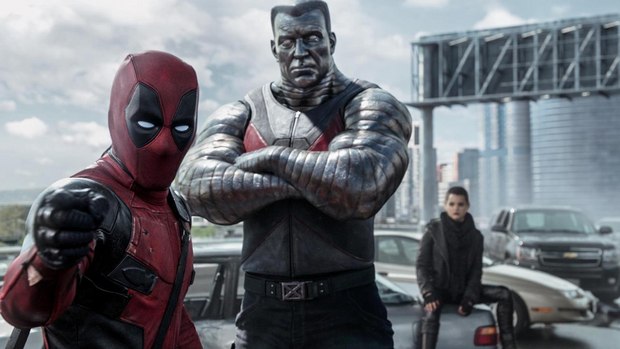Production VFX supervisor Dan Glass doubles down on the creation of a more unified Colossus with simultaneous facial capture and voice performance, and geometry-based character animation.
In Deadpool 2, directed by former stunt coordinator David Leitch, the snark has been combined with greater superhero stakes and time-traveling jeopardy, thanks to the addition of the cybernetic Cable (played by Josh Brolin), the teenage Firefist (Julian Dennison), and the immense Juggernaut (voiced by Ryan Reynolds).
Dan Glass (The Matrix sequels and The Tree of Life), who has moved over to Double Negative from Method Studios as senior VFX supervisor, oversaw the work, which was divided among DNEG, Framestore Montreal, Method, and Weta Digital. He wanted to maintain the franchise’s gritty visual style, while dealing with the new characters and improving the look of Colossus to get him ready for his big CG fight with Juggernaut. Weta even made subtle adjustments to the eye expressions of Deadpool (Reynolds) through his mask.
“We wanted Cable to feel real and obviously relied on Josh’s performance,” Glass said. “The arm we designed [at DNEG] to have a dirty, down-future look, and a lot of detail went into making that material feel bending the way the cables all intertwine and engage. It’s physically-correct mechanics that you can understand and see. The idea we had is that his hand is fully evolved mechanically and, as you progress up the arm and across the chest, you see this transition between a metal cyborg and some kind of strange virus that transitioned into flesh and bone.”
This required a lot of matchmoving, made all the more difficult because of the use of anamorphic lenses. “On the one hand, you’ve got all of this comic book lore that you need to be respectful of,” added Glass. “On the other hand, Cable in the comic books is drawn a lot of different ways. so you have some creative freedom.”
When it came to Firefist, Glass wanted to stay away from the typically cartoony look of CG fire balls. “I had this idea,” he said, “what if he actually generates heat that leads to combustion of things he interacts with? That led to tests of him pushing out super-heated air. Two things I thought you could justify from it: The expansion pressure of the super-heated air destroyed objects because of the force. And then, simultaneously, the heat combustion would cause wood to catch fire. We developed the simulation with DNEG and collaborated with the special effects team, which did practical fire and destruction that they merged.”
Of course, preparing for the climactic slugfest between Colossus and Juggernaut, the step-brother of Professor X, who shields himself with metal helmet, offered the greatest animation challenges for Framestore (assisted by previs and postvis from The Third Floor).
First, though, Colossus had to get into shape. In the first movie, the metal giant was Frankenstein-ed together with different facial and mocap performances. This time, he’s more unified. Kapicic’s facial capture and voice performance were simultaneous. Andrei Tricoteux again did mocap, and they built a helmet that could represent the Colossus’s on-set height for accurate camera positioning.
Additionally, Tricoteux wore gloves, a chest piece, and three strips of metal that ran down his arm from the helmet. The art department aged the accessories so they had the correct weathered look. “Physically, we gave him a bit of a workout,” explained Glass. “He’s a lot more chiseled and angular.”
Another animation improvement meant creating more believable flexing and punching by Colossus. The first movie used “live texturing,” which allowed for those iconic metal ridges across his arms. However, Glass wanted to do it with greater geometric precision, so Framestore animators provided a combination of shape movement and distortion for those really brutal blows. “We focused on the geometry and that gave us moments when he’s fighting that you see the metal rings move under that pressure.”
For Juggernaut, the animators modeled his face on director Leitch, creating a library of shapes and expressions. Reynolds provided both the voice and facial animation, which were greatly modified for the final performance. “He needed to move convincingly, so we studied muscle builders walking and running,” said Glass. “The 6-foot, 8-inch stand-in also needed a helmet extension to provide full 9-foot, 6-inch height so we had the right representation. We built his helmet full scale so a stunt guy could climb on top of it during the struggle for reference.”
It was a challenge for Framestore to animate the helmet in a way that provided enough room for the character to move its head and have it work with the rig underneath, which controls Juggernaut’s complex muscle system.
As for the fight choreography, Leitch wanted a visceral, brutal brawl, in which Juggernaut bashes Colossus’s face and knocks out a tooth before sustaining physical damage himself. “We had two stunt players that were comparable to the height differential,” added Glass. “Dave was able to work live and interactively with them and do the beats that we wanted in a mocap stage. We then fed that into post-vis that we could lay together, and then timed it and built to camera.”
Ironically, the straight-laced Colossus fights dirty because he’s so overmatched. “He grabs the fence post and stabs him in the eye and the groin,” Glass said.
In other words, Colossus climbs down into the gutter and fights like Deadpool.




















